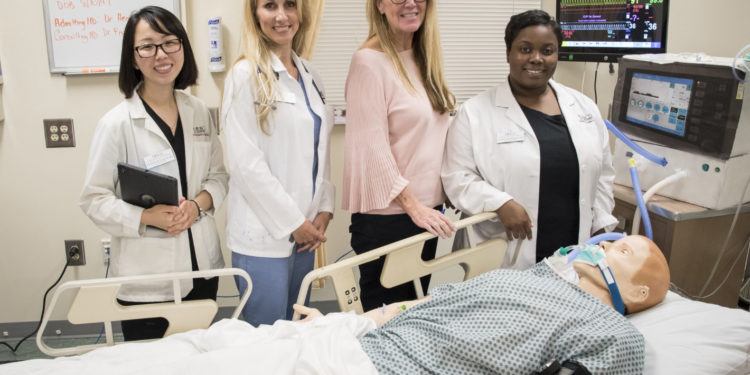Sickle Cell Disease Genetics Case Study Comprehensive Nursing Paper Example
Sickle cell disease is a genetic disorder passed down from parents to children. Sickle cell anemia develops due to sickle cells that prevent blood flow to organs, depriving them of blood and oxygen, potentially damaging nerves and organs like the liver, kidneys, and spleen, and sometimes leading to death. Such complications are preventable with early genetic testing and screening to inform early interventions. This paper discusses health policy influence on genetic testing and screening, societal, cultural, and environmental factors influencing the cause of sickle cell disease, the process a patient may go through relating to the disease, and preventative measures of sickle cell disease.(Sickle Cell Disease Genetics Case Study Comprehensive Nursing Paper Example)

Influence of Healthcare Policies on Genetic Testing and Screening
Genetic testing and screening help determine whether an individual has or will develop a genetic disorder. If the blood tests are unclear, individuals with sickle cell anemia require genetic testing to confirm a diagnosis. Genetic testing and screening for sickle cell anemia can take place prenatal or in newborns (National Human Genome Research Institute, 2019). However, genetic testing is under federal regulations through the Food and Drug Administration (FDA), the Centers for Medicare and Medicaid Services (CMS), and the Federal Trade Commission (FTC). Regulation is necessary to ensure analytical and clinical validity and clinical utility.(Sickle Cell Disease Genetics Case Study Comprehensive Nursing Paper Example)
The degree of genetic test oversight has considerable medical, social, ethical, legal, economic, and health policy implications. Healthcare policies and oversight impact people who undergo testing, conduct genetic testing, and develop tests (CDC, 2022). Genetic testing is accorded a similar level of oversight as nongenetic testing, occurring majorly through the Clinical Laboratory Improvement Amendments (CLIA) (42 C.F.R. 493), the Federal Food, Drug, and Cosmetics Act (21 U.S.C. 301), and during investigational stages, Federal Policy for the Protection of Human Subjects (45 C.F.R. 46, 21 C.F.R. 50 and 56) (CDC, 2022). Most new genetic tests are established and offered as clinical laboratory services, called in-house tests or home brews.(Sickle Cell Disease Genetics Case Study Comprehensive Nursing Paper Example)
Despite the number of genetic tests being developed increasing, the FDA, per the Secretary’s Advisory Committee on Genetic Testing (SACGT), created in 1998 to inform the U.S. Department of Health and Human Services, should review all genetic tests before they are utilized for clinical and public health reasons (CDC, 2022). The SACGT provides recommendations to the FDA to help with the review. It also augments CLIA regulations to offer particular provisions that ensure the quality of laboratories developing and performing genetic tests (CDC, 2022). CLIA requirements guide laboratories’ certification in areas like cytology and microbiology.(Sickle Cell Disease Genetics Case Study Comprehensive Nursing Paper Example)
Health policies for sickle cell anemia seek to organize screening and care to reach populations at increased risk of developing the disease. Each genetic testing developed for sickle cell anemia raises significant issues for public health, medicine, and social policy concerning the circumstances under which testing should be carried out and implemented and using the test results (National Human Genome Research Institute, 2019). There are discussions about policies that would make genetic testing mandatory or allow people to choose or refuse the test. Policies also guide newborn screening in some states and whether people can access the results of the tests. Additionally, policies inform how results should be used and the necessary protections in place if they are released to third parties like insurers or employers. (Sickle Cell Disease Genetics Case Study Comprehensive Nursing Paper Example)
The Societal, Cultural, and Environmental Influences for the Cause of Sickle Cell Disease
Currently, no intervention exists to prevent sickle cell anemia from developing, but particular factors can influence its development process, severity, and hospital attendance. Societal, cultural, and economic determinants influence the development of sickle cell anemia. Research shows that environmental factors like air quality, climate, exercise and infection, and socio-economics are vital in developing sickle cell anaemia and its severity (Tewari et al., 2019). For instance, studies show increased exposure to cold or wind leads to acute pain and increased hospital attendance. Moreover, air pollutants are interconnected and increase hospital attendance, although high atmospheric carbon monoxide benefits individuals with sickle cell disease. Individuals who exercise regularly experience significant psychological changes, although they might be overshadowed by improved cardiovascular health.(Sickle Cell Disease Genetics Case Study Comprehensive Nursing Paper Example)
Additionally, research shows that most people developing sickle cell disease live in low-income areas, implying the impact of socioeconomic factors. Factors, including social exclusion, disease-related stigmatization, and financial stress, increase healthcare encounters (Williams, 2019). Most sickle cell disease patients experience unmet social needs linked to a lack of transportation, inability to pay medical costs, and maintaining stable social relationships and jobs. Generally, the frequency of healthcare encounters increases in individuals indicating behavioral problems like depression, anxiety, substance abuse and social factors like unemployment.(Sickle Cell Disease Genetics Case Study Comprehensive Nursing Paper Example)

The Process a Patient May Go Through as it Relates to Sickle Cell Disease
Strong research evidence links nutrition to the propagation of sickle cell disease symptoms like joint pain, poor growth, anemia, and infection, which lead to painful episodes and recurrent hospitalization (Ohemeng et al., 2023). Therefore, patients must undergo nutrition assessment to help develop a balanced diet to foster an immune-healthy environment to prevent or curb sickling. Healthy nutrition would also help prevent hypermetabolism, which leads to quick nutrient consumption among sickle cell disease patients. Nutrition assessment early in the process would allow adopting healthy diets early to support growth and meet overall health needs (Ohemeng et al., 2023). Such diets should contain vitamins from fruits, vegetables, whole grains, and legumes. Supplementation with multivitamins can also be recommended to address nutrient deficiency.(Sickle Cell Disease Genetics Case Study Comprehensive Nursing Paper Example)
Screening helps confirm sickle cell disease diagnosis. Screening involves blood tests to identify the presence of the sickle cell form of hemoglobin. Screening is recommended before the mother is 10 weeks pregnant and for newborns to ensure early interventions. Early screening also allows the parent and child to have more tests and for the pregnant woman to determine whether the child will be affected if the mother is a carrier of the disorder (Sedrak & Kondamudi, 2022). Genetic testing is used in diagnosing sickle cell disease and establishing an individual’s type of sickle cell disease if the blood tests are unclear. Genetic testing can help providers ascertain whether an individual has a single or both copies of the sickle hemoglobin gene.(Sickle Cell Disease Genetics Case Study Comprehensive Nursing Paper Example)
Individuals diagnosed with sickle cell disease know that their life expectancy reduces overall, probably by 20 to 30 years, compared to normal populations (Sedrak & Kondamudi, 2022). However, therapy advances are helping prolong survival. Curing sickle cell disease is complex, and most people only reduce the progression and severity of sickle cell disease symptoms like painful experiences. The only cure is a bone marrow transplant, which is viable for some patients (NHLBI, 2023). The preoperative transfusion therapy can help increase hemoglobin levels to 1 g/dL. An early diagnosis would allow the provider to recommend medicines or transfusions to curb complications like chronic pain. Early prescription of opioids can aid with severe pain linked to a vasoocclusive crisis. Avascular necrosis can be treated using analgesics and physical therapy (Abdel-Hadi et al., 2023). Treatment effectiveness can be monitored by tracking changes in symptom severity and frequency.(Sickle Cell Disease Genetics Case Study Comprehensive Nursing Paper Example)
Preventative Measures That Can be Used for Sickle Cell Disease
It is almost impossible to prevent most genetic disorders from occurring because they are passed down genetically from parents. Understanding the family history of a genetic disorder and sharing this with the provider can help inform strategies to prevent passing it to the next generation or preventing complications due to the genetic disorder (National Human Genome Research Institute, 2019). For instance, prenatal screening is an intervention that can help prevent the passing of a genetic disorder to the next generation. Parents can decide whether to have the baby after a positive screening. If adopted ethically, prenatal screening can help reduce the prevalence rates of diseases like sickle cell anemia.(Sickle Cell Disease Genetics Case Study Comprehensive Nursing Paper Example)
Most interventions are recommended to prevent complications from occurring. For instance, there are no ways today to prevent sickle cell anemia from occurring. However, interventions like avoiding infections through proper vaccination, getting routine eye examinations, drinking fluids to prevent dehydration, eating healthy foods to boost the immune system, avoiding smoking, and exercising safely and regularly can help prevent complications like acute pain and poor growth (National Human Genome Research Institute, 2019). These interventions can provide positive outcomes in treating the disease and increase life expectancy.(Sickle Cell Disease Genetics Case Study Comprehensive Nursing Paper Example)
Conclusion
Sickle cell disease is a genetic disorder only confirmed through genetic testing and screening. Federal regulations through bodies and institutions like the FDA help regulate genetic testing and screening, including who develops the tests, who use the tests, who receive the tests, where the tests are done, and how the results will be utilized. It is impossible to prevent sickle cell disease from developing if an individual is positive for sickle cell hemoglobin, but societal, cultural, and environmental factors can impact the severity of the disease and hospital attendance. Nutrition assessment is vital in people with sickle cell disease because healthy nutrition is associated with prolonged survival and reduced symptoms severity. It can be adopted as a preventative measure and treatment modality. Prenatal genetic screening can help prevent passing down sickle disease to the next generation, but only when done ethically. Interventions like healthy eating, drinking adequate fluids, avoiding alcohol and tobacco, exercising regularly and safely, and avoiding infection can help prevent complications associated with sickle cell disease. (Sickle Cell Disease Genetics Case Study Comprehensive Nursing Paper Example)
References
Abdel-Hadi, L., Ventura Carmenate, Y., Castillo-Aleman, Y. M., Sheikh, S., Zakaria, A., & Phillips, J. (2023). Treatment of sickle cell disease – options and perspective. American journal of blood research, 13(2), 61–70.(Sickle Cell Disease Genetics Case Study Comprehensive Nursing Paper Example)
CDC. (2022, October 7). Integrating genomics into public health policy and practice. Centers for Disease Control and Prevention. https://www.cdc.gov/genomics/resources/books/beskow.htm(Sickle Cell Disease Genetics Case Study Comprehensive Nursing Paper Example)
National Human Genome Research Institute. (2019, March 13). Regulation of genetic tests. Genome.gov. https://www.genome.gov/about-genomics/policy-issues/Regulation-of-Genetic-Tests
National Human Genome Research Institute. (2019, March 9). Genetics, disease prevention and treatment FAQ. Genome.gov. https://www.genome.gov/FAQ/Genetics-Disease-Prevention-and-Treatment(Sickle Cell Disease Genetics Case Study Comprehensive Nursing Paper Example)
NHLBI. (2023, August 8). Treatment. NHLBI, NIH. https://www.nhlbi.nih.gov/health/sickle-cell-disease/treatment(Sickle Cell Disease Genetics Case Study Comprehensive Nursing Paper Example)
Ohemeng, A., Nartey, E. B., Quaidoo, E., Ansong, R. S., & Asiedu, M. S. (2023). Knowledge and nutrition-related practices among caregivers of adolescents with sickle cell disease in the Greater Accra region of Ghana. BMC public health, 23(1), 434. https://doi.org/10.1186/s12889-023-15343-1
Sedrak, A., & Kondamudi, N. P. (2022). Sickle Cell Disease. In: StatPearls [Internet]. Treasure Island (FL). StatPearls Publishing. https://www.ncbi.nlm.nih.gov/books/NBK482384/
Tewari, S., Brousse, V., Piel, F. B., Menzel, S., & Rees, D. C. (2019). Environmental determinants of severity in sickle cell disease. Haematologica, 100(9), 1108–1116. https://doi.org/10.3324/haematol.2018.120030(Sickle Cell Disease Genetics Case Study Comprehensive Nursing Paper Example)
Williams, H., Silva, R. N. S., Cline, D., Freiermuth, C., & Tanabe, P. (2019). Social and behavioral factors in sickle cell disease: employment predicts decreased health care utilization. Journal of health care for the poor and underserved, 29(2), 814–829. https://doi.org/10.1353/hpu.2018.0060(Sickle Cell Disease Genetics Case Study Comprehensive Nursing Paper Example)
https://www.ncbi.nlm.nih.gov/

